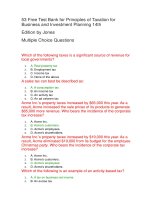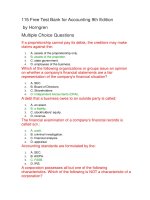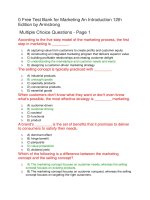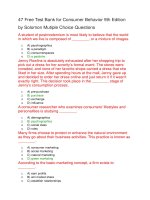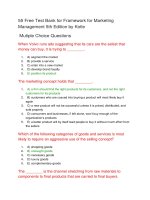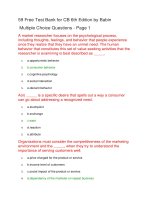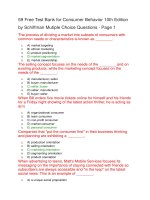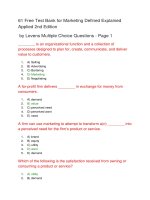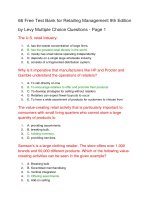53 free test bank for retailing 8th edition
Bạn đang xem bản rút gọn của tài liệu. Xem và tải ngay bản đầy đủ của tài liệu tại đây (42.12 KB, 11 trang )
53 Free Test Bank for Retailing 8th Edition
by Dunne Mutiple Choice Questions
Identify the incorrect statement about e-tailing.
1.
2.
a.It enables consumers to shop when they like and from where they like.
b.It provides access to vast amounts of information, ranging from a product’s
attributes to who has the lowest price.
3. c.Many e-tailers offer personalized help online.
4. d.With some Internet websites, individuals can band together for group
buying.
5. e.Some e-tailers may have to discontinue some product categories as
consumers engage in outshopping.
The North American Industrial Classification System (NAICS) code
is used to reflect the:
1.
2.
3.
4.
5.
a.location of the retailer.
b.industrial category of the retailer.
c.type of merchandise the retailer sells.
d.size of the retailer in terms of sales dollars.
e.margin the retailer maintains in its industrial category.
In attempting to determine whether a new fast-food restaurant
should be opened in a small town, a retailer gathered information
on demographics, competitors’ sales, and real estate available in
that area. The retailer was employing the _____ method of retail
decision-making.
1.
2.
3.
4.
5.
a.analytical
b.creative
c.intuitive
d.strategic
e.tactical
An environmental orientation will allow retailers to:
1.
2.
3.
a.anticipate and adapt continuously to external forces.
b.adapt systematically to a changing environment.
c.focus on fundamental management of assets, sales revenues and
expenses.
4. d.focus on the need to collect and analyze data.
5. e.to acquire merchandise from suppliers.
A product sold at or below cost is known as:
1.
2.
a.freebie marketing.
b.a loss leader.
3.
4.
5.
c.product bundling.
d.a bait and switch.
e.product churning.
A (an) _____________ perspective can result in a standardized set
of procedures, success formulas and guidelines.
1.
2.
3.
4.
5.
a.creative
b.administrative
c.intuitive
d.strategic
e.analytical
Buying is defined as:
1.
2.
3.
4.
5.
6.
7.
a.the career path that involves responsibility for selecting, for
selecting,training and
evaluating personnel.
b.the career path that enables you to select merchandise lines through etailing.
c.the career path whereby one use quantitative tools to develop appropriate
buying plans for the store’s merchandise lines.
d.the career path that allows complete independence in ordering merchandise
for the store.
e.the career path that will eventually lead to vice president.
Retailing is defined as:
1.
2.
3.
4.
5.
a.any exchange of cash and/or credit for goods or services between channel
members.
b.a fairly stable and unchanging industry that has a major impact on society.
c.the final activities and steps needed to place merchandise made elsewhere
into the hands of the consumer or to provide services to the consumer.
d.the sale of any good or service by the producer to a channel member.
e.the activities and steps needed to transfer goods and/or services between
channel members.
Retailers that practice both analytical and creative management
should be consistently more:
1.
2.
3.
4.
5.
a.profitable.
b.vibrant.
c.liquid.
d.successful in terms of market share.
e.stable.
Given the ever-changing needs of the retail environment, retail
managers who possess _____ are highly sought after as these
managers have the ability to quickly alter plans to accommodate
changes in trends, styles and attitudes.
1.
2.
3.
4.
5.
a.flexibility
b.leadership
c.initiative
d.enthusiasm
e.creativity
If you choose the store-management path, which of the following
statements would be true?
1.
2.
3.
4.
5.
a.Selecting, training, evaluation, and all other aspects of personnel
management are your responsibility.
b.You will have to use quantitative tools such as the merchandise budget in
your work.
c.You are responsible for selecting the merchandise.
d.You must select the vendors and negotiate terms with them.
e.Store managers, who usually work out of the retailer’s main office but do
spend a great amount of time traveling have to develop appropriate buying
plans for their merchandise lines.
_____ refers to the number of times per year, on average, that a
retailer sells its inventory.
1.
2.
3.
4.
5.
a.Periodic inventory
b.Carrying cost of inventory
c.Inventory reserve
d.Perpetual inventory
e.Inventory turnover
A retailer that carries such a large quantity of merchandise in a
single category at such good prices that it makes it impossible for
customers to walk out without purchasing what they need, thus
killing the competition, is known as a(n):
1.
2.
3.
4.
5.
a.capital-based retailer.
b.category killer.
c.divertive competitor.
d.killer bee.
e.supercenter.
In the text, when the authors refer to chain stores they are normally
referring to operations having _____ or more units.
1.
2.
3.
4.
5.
a.2
b.7
c.10
d.20
e.25
Retail managers are often forced to deal with many issues,
functions, and projects at the same time. Establishing priorities,
plans, and follow through to achieve results demonstrates which
prerequisite for success?
1.
2.
3.
4.
5.
a.Initiative
b.Leadership
c.Risk Taking
d.Organization
e.Stress Tolerance
Which of the following is an example of a retail transaction?
1.
2.
3.
a.A firm pays a printer for printing business cards.
b.A supermarket purchases eggs from a local farmer for resale.
c.A student purchases a magazine subscription from a door-to-door
salesperson.
4. d.A manager of a college bookstore purchases extra copies of your Retailing
text from the publisher.
5. e.A department store purchases cosmetics from a manufacturer for sale in its
stores.
Jewelry stores are generally categorized as:
1.
2.
3.
4.
5.
a.low-margin/high-turnover.
b.high-margin/low-turnover.
c.low-margin/low-turnover.
d.high-margin/high-turnover.
e.low-margin/moderate-turnover.
Which of the following is NOT an operating expense?
1.
2.
3.
4.
5.
a.Rent
b.Cost of goods sold
c.Depreciation
d.Utilities
e.Wages
If a retailer had an average inventory of $80,000 (retail) and annual
sales of $480,000, how many times has that retailer turned over its
inventory?
1.
2.
3.
4.
5.
a.Four times a month
b.Six times a month
c.Four times a year
d.Six times a year
e.Eight times a year
Rapidly growing chain stores usually find it necessary to transfer
store managers for the following reason:
1.
2.
3.
a.to allow managers to live in the geographic location of their choice.
b.to open new stores in new geographic locations.
c.to make it possible for new managers to work in established business
locations.
4. d.to gain additional retail experience.
5. e.to adhere to the principle of geographic mobility.
The dominance of Walmart can be attributed to Sam Walton's
realization that:
1.
2.
a.most of any product's cost gets added after the item is produced.
b.consumers desire great selection and are willing to pay higher prices to
obtain that selection.
3. c.most consumers prefer to complete all of their shopping in one store to
minimize their overall shopping time.
4. d.most consumers would prefer to shop in large stores rather than small
stores as they believe that larger stores offer higher customer service.
5. e.the company’s primary focus should be on its profits.
Due to increased corporate responsibilities, the manager of a
sporting goods store has asked the assistant manager to take
responsibility for screening and hiring new sales associates. The
manager is allowing the assistant to make the decisions
independently, but has scheduled weekly meetings for the two to
discuss any issues of concern and to provide insight, if needed. The
manager is demonstrating which desirable retailing attribute?
1.
2.
3.
4.
5.
a.Prioritizing
b.Leadership
c.Creativity
d.Laziness
e.Enthusiasm
Which of the following statements about private label brands is
false?
1.
a.Private labels allow the retailer to control the costs associated with
developing, making, sourcing, and promoting the label.
2. b.Private labels are advertised in the newspaper as brands and are heavily
promoted in stores.
3. c.Private label brands are usually sold at lower prices than manufacturer's
brands.
4. d.Private label brands have been successful in the grocery industry, while
failing in most other retail sectors.
5.
e.Some retailers can’t use private labels unless they are part of a buying
group.
A channel captain:
1.
2.
3.
4.
5.
a.is a retailer that carries a large amount of merchandise in the marketing
channel at good prices.
b.helps the customer gets needed information in the store and then orders it
online for a lower price and to avoid paying state sales tax.
c.is the institution in the marketing channel that is able to plan for and get
other channel institutions to engage in activities they might not otherwise
engage in.
d.provides information on the structure of retail competition.
e.is a retailer that develops its own brand name and contracts with a
manufacturer to produce the product with the retailer’s brand.
Which of the following is NOT one of the ways by which retailers
are categorized?
1.
2.
3.
4.
5.
a.Location
b.Market share
c.Number of outlets
d.Size
e.Margin vs. turnover
_____ is the result of the pressure being placed on many retailers
to increase profits by carrying additional merchandise or services
that will also increase store traffic.
1.
2.
3.
4.
5.
a.Cross-merchandising
b.Piggybacking
c.Automatic merchandising
d.Product diversification
e.Scrambled merchandising
Which of the following statements about NAICS codes is false?
1.
2.
a.Three-digit NAICS codes are very useful to the retail analyst.
b.In almost all instances, the NAICS code reflects the type of merchandise the
retailer sells.
3. c.Four-digit NAICS codes provide much more information on the structure of
retail competition than three-digit NAICS codes.
4. d.The U.S. Bureau of Census classifies all retailers using three-digit NAICS
codes.
5. e.The major portion of a retailer’s competition comes from other retailers in its
NAICS category.
Which of the following characteristics is NOT desirable for a retail
manager to possess?
1.
a.Enthusiasm
2.
3.
4.
5.
b.Creativity
c.Analytical skills
d.Indecisiveness
e.Initiative
One of the most dramatic changes created by e-tailing is a shift in
power between retailers and consumers. This shift in power is
derived from:
1.
2.
3.
4.
5.
a.the ability of consumers to purchase from retailers in other countries as a
result of the Internet.
b.the inability of Internet retailers to compete with more traditional bricks-andmortar retailers.
c.the loss of control of pricing information by retailers due to the information
dissemination capabilities of the Internet.
d.the lack of competition in e-tailing.
e.the decreased power of consumers when transacting and negotiating with
retailers.
Large chains which recognize that consumer tastes vary by region
often use a(n) _____ to give each store the flexibility to adjust its
merchandise mix.
1.
2.
3.
4.
5.
a.standard stock list
b.flexible merchandise planning center
c.private label branding strategy
d.localized merchandise planning center
e.optional stock list
Which of the following is true about a retailing career?
1.
2.
3.
4.
5.
a.Since retailing is so diverse, all individuals are suited for a retail career.
b.A career in retailing is limited to those living in densely populated areas.
c.Starting salaries are higher in retailing than in most other careers.
d.The potential for retail career advancement is high.
e.Nationally, the number of careers in retailing is expected to decline over the
next decade.
A successful retail manager will use the:
1.
2.
3.
4.
5.
a.analytical method only.
b.creative method only.
c.strategic method only.
d.analytical and creative methods.
e.analytical, creative, and strategic methods.
Which of the following statements is correct?
1.
a.Operating costs per sales dollar are usually lower for larger retailers than
they are for small retailers.
2.
3.
4.
5.
b.Larger retail firms generally have higher operating costs per sales dollar.
c.Retailers cannot be classified by number of stores.
d.Retailers are rarely classified by sales volume.
e.The operating performance of retailers has no relationship to retailers' size.
Which of the following demographic factors have been significant
sources of change over the last decade?
1.
2.
3.
4.
5.
a.Fluctuating birth rate, the increasing number of immigrants, the growing
importance of Generation-Y consumers, the fact that Generation-Xers are
starting to reach middle age and that baby boomers are nearing retirement
age.
b.Aging of baby boomers, declining household incomes, decline in part-time
workers, redistribution of income levels, and the rise in the number of college
graduates.
c.Increasing number of women in the workplace, declining household
incomes, rise in part-time workers, rise in teenage suicide, and redistribution of
income levels.
d.Fluctuating birth rate, the growing importance of Generation-X consumers,
the fact that Generation-Yers are starting to reach middle age, and the
increasing number of women in the workforce.
e.Fluctuating birth rate, the growing importance of Generation-X consumers,
the fact that Generation-Yers are starting to reach middle age, and the decline
in household incomes.
The fastest growing form of e-tailing or e-commerce is
1.
2.
3.
4.
5.
a.texting
b.m-tailing or m-commerce
c.social network advertising
d.personalized on line help
e.on-line auctions
If a retailer has a 25 percent gross-margin percentage, how much
will be generated in gross-margin dollars for each $100 of sales?
1.
2.
3.
4.
5.
a.$25.00
b.$75.00
c.$2.50
d.$4.50
e.$7.50
An operator of which of the following establishments is NOT a
retailer?
1.
2.
3.
4.
5.
a.A catering service specializing in weddings.
b.A computer firm selling software to households via the Internet.
c.A student going door-to-door selling magazine subscriptions.
d.A corporate property management firm.
e.An ice cream shop in the student union.
An alternative to scrambling merchandise to increase profitability
that many retailers are implementing is:
1.
2.
3.
4.
5.
a.limiting Internet access to customers in stores.
b.selling many different and unrelated items.
c.becoming a discount store.
d.reducing store size.
e.selling merchandise on line only.
Market share refers to:
1.
2.
3.
4.
5.
a.the number of competitors a retailer must contend with.
b.a retailer's total sales divided by total market sales.
c.agreements whereby retailers attempt to "share" certain costs.
d.the total sales a retailer has generated from the target market.
e.the portion of a retailer's sales that represent profit.
Retailers with several units are a stronger competitive threat
because
1.
2.
3.
a.they can focus all their efforts on one trade area
b.they are generally owner and family operated
c.they can spread many fixed costs over a number of stores and can achieve
economies in purchasing
4. d.they can tailor their merchandising to one trade area in each unit
5. e.they can spot customer desires sooner and respond faster.
Gross margin can be defined as:
1.
2.
a.net sales minus the cost of the goods sold.
b.the selling price charged for a piece of merchandise or a service plus
variable operating expenses.
3. c.the difference between total profits and total expenses.
4. d.the cost of merchandise in a retailer's inventory.
5. e.the cost of goods sold at less operating expenses.
_____ occurs when the customer gets needed information in the
store and then orders it online for a lower price and to avoid paying
state sales tax.
1.
2.
3.
4.
5.
a.Channel Surfing
b.Same-store retailing
c.Bricks-and-mortar retailing
d.Social shopping
e.Outshopping
Walmart became the world’s largest retailer by:
1.
2.
a.offering better value in price and quality.
b.cutting unnecessary costs.
3.
4.
5.
c.concentrating only on profits.
d.selling products at low prices.
e.becoming more service oriented.
An inventory turnover of 3.7 indicates that a retailer sells its
inventory:
1.
2.
3.
4.
5.
a.for 37 percent of cost times cost.
b.every 3.7 months.
c.3.7 times a year.
d.about every four weeks.
e.about every four days.
What are the five most popular methods of classifying retailers?
1.
2.
3.
4.
5.
a.Census Bureau, inventory method, margin versus turnover, location, and
size
b.Census Bureau, margin versus turnover, inventory method, channel system,
and size
c.Census Bureau, number of outlets, margin versus turnover, location, and
size
d.number of outlets, margin versus turnover, location, size, and inventory
method
e.number of outlets, Census Bureau, inventory method, location, and size
_____ is a merchandising method in which all stores in a retail
chain stock the same merchandise.
1.
2.
3.
4.
5.
a.An optional stock list
b.Scrambled merchandising
c.A standard stock list
d.Automatic merchandising
e.Cross-merchandising
_____ is the ability to make rapid decisions, to render judgements,
take action and commit oneself to a course of action until
completion.
1.
2.
3.
4.
5.
a.Flexibility
b.Leadership
c.Initiative
d.Enthusiasm
e.Decisiveness
Which of the following is an example of a non-traditional location
that retailers are selecting:
1.
2.
3.
a.travel stop plazas along interstate highways.
b.multi retail store shopping centers.
c.suburban shopping malls.
4.
5.
d.outlet malls.
e.local corner stores.
The best way to categorize retailers is:
1.
2.
3.
4.
5.
a.by the U.S. Bureau of Census’ three-digit North American Industrial
Classification Systems (NAICS).
b.by the retailers' locations.
c.by the number of outlets the store maintains.
d.by the retailers' margins and turnover.
e.there is no single accepted method of classifying retail competitors.
Which of the following would NOT be considered a "category
killer?"
1.
2.
3.
4.
5.
a.Office Depot
b.PetSmart
c.Toys "R" Us
d.Target
e.Best Buy
Due to the ever-changing retail marketplace, the store manager has
initiated many novel ideas and solutions to increase overall store
sales. The manager is demonstrating which desirable retailing
attribute?
1.
2.
3.
4.
5.
a.Prioritizing
b.Leadership
c.Creativity
d.Hard Work
e.Enthusiasm
Same-store sales compare:
1.
2.
3.
4.
5.
a.an individual store’s sales to its sales for the same month in the previous
year.
b.clearance efforts with holiday mark-downs.
c.two stores in the same district to one another.
d.advertising circulars with in-store promotions.
e.revenue with expenses.
Which type of retail establishment is least likely to adopt scrambled
merchandising?
1.
2.
3.
4.
5.
a.An ATM
b.A drug-store
c.A supermarket
d.A specialty store
e.A convenience market
